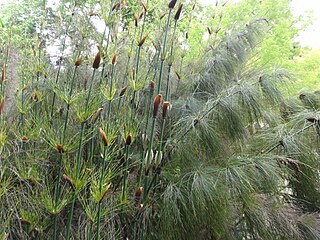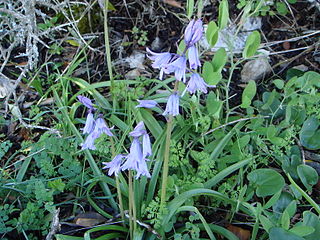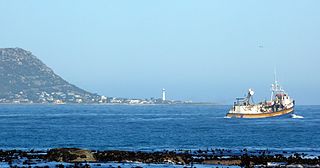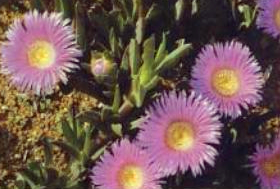
Amaryllis is the only genus in the subtribe Amaryllidinae. It is a small genus of flowering bulbs, with two species. The better known of the two, Amaryllis belladonna, is a native of the Western Cape region of South Africa, particularly the rocky southwest area between the Olifants River Valley and Knysna.

Hyacinthoides non-scripta is a bulbous perennial plant, found in Atlantic areas from north-western Spain to Great Britain, Ireland and associated islands, and also frequently used as a garden plant. It is known in English as the common bluebell or simply bluebell, a name which is used in Scotland to refer to the harebell, Campanula rotundifolia. In spring, H. non-scripta produces a nodding, one-sided inflorescence of 5–12 tubular, sweet-scented violet–blue flowers, with strongly recurved tepals, and 3–6 long, linear, basal leaves.

Fynbos is a small belt of natural shrubland or heathland vegetation located in the Western Cape and Eastern Cape provinces of South Africa. This area is predominantly coastal and mountainous, with a Mediterranean climate and rainy winters. The fynbos ecoregion is within the Mediterranean forests, woodlands, and scrub biome. In fields related to biogeography, fynbos is known for its exceptional degree of biodiversity and endemism, consisting of about 80% species of the Cape floral kingdom, where nearly 6,000 of them are endemic. This land continues to face severe human-caused threats, but due to the many economic uses of the fynbos, conservation efforts are being made to help restore it.

The Restionaceae, also called restiads and restios, are a family of flowering plants native to the Southern Hemisphere; they vary from a few centimeters to 3 meters in height. Following the APG IV (2016): the family now includes the former families Anarthriaceae, Centrolepidaceae and Lyginiaceae, and as such includes 51 genera with 572 known species. Based on evidence from fossil pollen, the Restionaceae likely originated more than 65 million years ago during the Late Cretaceous period, when the southern continents were still part of Gondwana.

Limonium is a genus of about 600 flowering plant species. Members are also known as sea-lavender, statice, caspia or marsh-rosemary. Despite their common names, species are not related to the lavenders or to rosemary. They are instead in Plumbaginaceae, the plumbago or leadwort family. The generic name is from the Latin līmōnion, used by Pliny for a wild plant and is ultimately derived from the Ancient Greek leimon.

Hyacinthoides hispanica, the Spanish bluebell or wood hyacinth, is a spring-flowering bulbous perennial native to the Iberian Peninsula. It is one of around a dozen species in the genus Hyacinthoides, others including the common bluebell in northwestern Europe, and the Italian bluebell further east in the Mediterranean region.

Kommetjie is a small town near Cape Town, in the Western Cape province of South Africa. It lies about halfway down the west coast of the Cape Peninsula, at the southern end of the long wide beach that runs northwards towards Chapman's Peak and Noordhoek. The community of Ocean View is located to its immediate south east.

Acacia saligna, commonly known by various names including coojong, golden wreath wattle, orange wattle, blue-leafed wattle, Western Australian golden wattle, and, in Africa, Port Jackson willow, is a small tree in the family Fabaceae. Native to Australia, it is widely distributed throughout the south west corner of Western Australia, extending north as far as the Murchison River, and east to Israelite Bay. The Noongar peoples know the tree as Cujong.

Thyrsites atun, known as the snoek in South Africa and as the barracouta in Australasia, is a long, thin species of snake mackerel found in the seas of the Southern Hemisphere, and a popular food fish in South Africa, particularly along the west and southwest coast. Despite its Australasian name, it is not closely related to the barracuda.

The Cape Floral Region is a floristic region located near the southern tip of South Africa. It is the only floristic region of the Cape Floristic Kingdom, and includes only one floristic province, known as the Cape Floristic Province.

The wildlife of South Africa consists of the flora and fauna of this country in southern Africa. The country has a range of different habitat types and an ecologically rich and diverse wildlife, vascular plants being particularly abundant, many of them endemic to the country. There are few forested areas, much savanna grassland, semi-arid Karoo vegetation and the fynbos of the Cape Floristic Region. Famed for its national parks and big game, 297 species of mammal have been recorded in South Africa, as well as 849 species of bird and over 20,000 species of vascular plants.

The geometric tortoise is a critically endangered species of tortoise and one of three members of the genus Psammobates. It is found in a very small section in the South-Western Cape of South Africa.

Lycium ferocissimum, the African boxthorn or boxthorn, is a shrub in the nightshade family (Solanaceae) indigenous to South Africa.

Cyanella is a genus of cormous perennial herbs native to South Africa and Namibia, first described for modern science in 1754.

Southern Afrotemperate Forest is a kind of tall, shady, multilayered indigenous South African forest. This is the main forest-type in the south-western part of South Africa, naturally extending from the Cape Peninsula in the west, as far as Port Elizabeth in the east. In this range, it usually occurs in small forest pockets, surrounded by fynbos vegetation.

Mediterranean scrub is a biome defined by the World Wide Fund for Nature. The biome is generally characterized by dry summers and rainy winters, although in some areas rainfall may be uniform. Summers are typically hot in low-lying inland locations but can be cool near colder seas. Winters are typically mild to cool in low-lying locations but can be cold in inland and higher locations. All these ecoregions are highly distinctive, collectively harboring 10% of the Earth's plant species.

Carpobrotus muirii is a succulent perennial of the family Aizoaceae, native to the Overberg region in the Western Cape, South Africa.
Tetragonia nigrescens is a plant native to southern Africa.

Cyanella lutea is a species of cormous herb, native to South Africa and southern Namibia, where it grows in clay-rich or loamy soils.



















